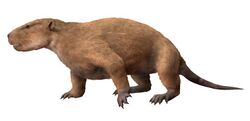Biology:Taeniolabidoidea
| Taeniolabidoidea | |
|---|---|

| |
| Taeniolabis taoensis life reconstruction. | |
| Scientific classification | |
| Domain: | Eukaryota |
| Kingdom: | Animalia |
| Phylum: | Chordata |
| Class: | Mammalia |
| Order: | †Multituberculata |
| Suborder: | †Cimolodonta |
| Superfamily: | †Taeniolabidoidea Sloan and van Valen, 1965 |
| Families and genera | |
Taeniolabidoidea is a group of extinct mammals known whose fossils can be found in North America and Asia. They were the largest members of the extinct order Multituberculata, as well as the largest non-therian mammals. [citation needed] Lambdopsalis even provides direct fossil evidence of mammalian fur in a fairly good state of preservation for a 60-million-year-old animal. [citation needed]Some of these animals were large for their time; Taeniolabis taoensis is the largest known multituberculate and though smaller, Yubaatar is the largest known Mesozoic Asian multituberculate.[2] T. taoensis averaged a body mass of 22.7 kilograms (50 lb).[3]
The group was initially established as a suborder, before being assigned the rank of a superfamily by McKenna and Bell in 1997.[4][5] Two families are recognised: the primarily North American Taeniolabididae, composed of Taeniolabis and Kimbetopsalis, and the exclusively Asian Lambdopsalidae, composed of Lambdopsalis, Sphenopsalis and Prionessus, with Valenopsalis being a basal form outside of either clade.[6] Some of the fossils are well-preserved. Though the possible taeniolabidoid Bubodens is known from the Lancian Late Cretaceous deposits of South Dakota,[7] and Yubaatar is known from Late Cretaceous deposits in the Henan Province,[8] the clade is otherwise only clearly represented in Paleocene strata.[9]
Members of this group have dental formulas of 2.0.1.21.0.1.2 or 2.0.2.21.0.1.2. Russell notes that the taeniolabidoids had ever-growing, self-sharpening incisors, much like modern rodents, and the premolars that are usually characteristic of multituberculates are sometimes lost in this family.[10] Derived characteristics of the taxon (apomorphies) include: "snout short and wide with anterior part of zygomatic arches directed transversely, resulting in a square-like shape of the skull (shared with Kogaionidae); frontals small, pointed posteriorly, almost or completely excluded from the orbital rim".[11]
Notes
References
- Dykes, Trevor. "Mesozoic Mammals; Eucosmodontidae, Microcosmodontidae and Taeniolabidoidea, an internet directory". http://home.arcor.de/ktdykes/taenio.htm.
- Kielan-Jaworowska, Zofia; Hurum, J.H. (2001). "Phylogeny and Systematics of Multituberculate Mammals". Paleontology 44 (3): 389-429. doi:10.1111/1475-4983.00185.
- Kielan-Jaworowska, Zofia; Qi, Tao (1990). "Fossorial adaptations of a Taeniolabidoid Multituberculate mammal from the Eocene of China". Vertebrata Palasiatica 28 (02): 83-94.
- McKenna, M.C.; Bell, S.K. (1997). Classification of Mammals Above the Species Level. Columbia University Press.
- Carroll, Robert I. (1988). Vertebrate Paleontology and Evolution. W.H.Freeman and Company. ISBN 0-716-71822-7.
- Williamson, Thomas E.; Brusatte, Stephen L.; Secord, Ross; Shelley, Sarah (2015). "A new taeniolabidoid multituberculate (Mammalia) from the middle Puercan of the Nacimiento Formation, New Mexico, and a revision of taeniolabidoid systematics and phylogeny". Zoological Journal of the Linnean Society 177: 183–208. doi:10.1111/zoj.12336.
- Wilson, Gregory P.; Evans, Alistair R.; Corfe, Ian J.; Smits, Peter D.; Fortelius, Mikael; Jernvall, Jukka (2012). "Adaptive radiation of multituberculate mammals before the extinction of dinosaurs". Nature 483: 457-460. doi:10.1038/nature10880.
- Xu, L.; Zhang, X.; Pu, H.; Jia, S.; Zhang, J.; Meng, J. (2015). "Largest known Mesozoic multituberculate from Eurasia and implications for multituberculate evolution and biology". Scientific Reports 5 (14950): 1-11.
Wikidata ☰ Q2474030 entry
 |

